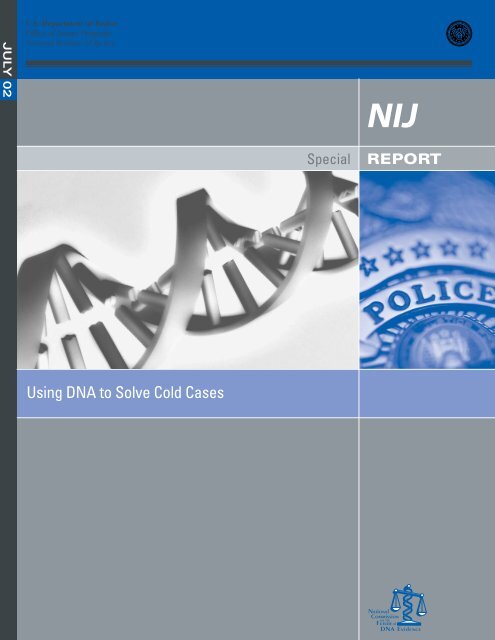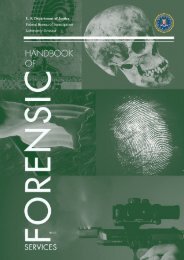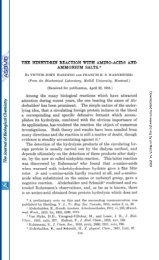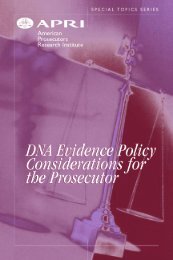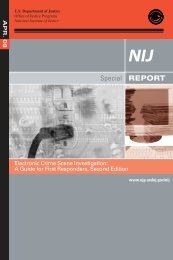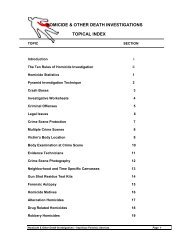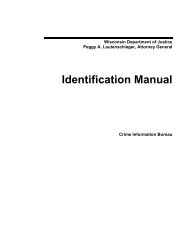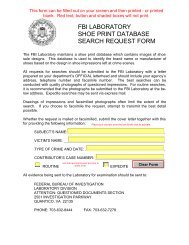Using DNA to Solve Cold Case - Imprimus Forensic Services
Using DNA to Solve Cold Case - Imprimus Forensic Services
Using DNA to Solve Cold Case - Imprimus Forensic Services
- No tags were found...
You also want an ePaper? Increase the reach of your titles
YUMPU automatically turns print PDFs into web optimized ePapers that Google loves.
JULY 02<strong>Using</strong> <strong>DNA</strong> <strong>to</strong> <strong>Solve</strong> <strong>Cold</strong> <strong>Case</strong>sNCJ 194197
National Commission on theFuture of <strong>DNA</strong> EvidenceIn 1995, the National Institute of Justice(NIJ) began research that would attempt<strong>to</strong> identify how often <strong>DNA</strong> had exoneratedwrongfully convicted defendants. Afterextensive study, NIJ published the reportConvicted by Juries, Exonerated byScience: <strong>Case</strong> Studies in the Use of <strong>DNA</strong>Evidence <strong>to</strong> Establish Innocence AfterTrial, which presents case studies of 28inmates for whom <strong>DNA</strong> analysis wasexculpa<strong>to</strong>ry.On learning of the breadth and scope ofthe issues related <strong>to</strong> forensic <strong>DNA</strong>, theAt<strong>to</strong>rney General asked NIJ <strong>to</strong> establishthe National Commission on the Future of<strong>DNA</strong> Evidence as a means <strong>to</strong> examine themost effective use of <strong>DNA</strong> in the criminaljustice system. The Commission wasappointed by the NIJ Direc<strong>to</strong>r and representedthe broad spectrum of the criminaljustice system. Chaired by the HonorableShirley S. Abrahamson, Chief Justice ofthe Wisconsin Supreme Court, the Commissionconsisted of representatives fromthe prosecution, the defense bar, lawenforcement, the scientific community,the medical examiner community, academia,and victims’ rights organizations.The Commission’s charge was <strong>to</strong> submitrecommendations <strong>to</strong> the At<strong>to</strong>rney Generalthat will help ensure the best use of <strong>DNA</strong>as a crimefighting <strong>to</strong>ol and foster its usethroughout the entire criminal justicesystem. Other focal areas for the Commission’sconsideration included crimescene investigation and evidencecollection, labora<strong>to</strong>ry funding, legal issues,and research and development. TheCommission’s working groups, consistingof commissioners and other experts,researched and examined various <strong>to</strong>picsand reported back <strong>to</strong> the Commission. Theworking groups’ reports were submitted<strong>to</strong> the full Commission for approval,amendment, or further discussion and providedthe Commission with backgroundfor its recommendations <strong>to</strong> the At<strong>to</strong>rneyGeneral.By nature of its representative compositionand its use of numerous working groups,the Commission received valuable inputfrom all areas of the criminal justice system.The broad scope of that input enabledthe Commission <strong>to</strong> develop recommendationsthat both maximize the investigativevalue of the technology and address theissues raised by its application.Commission membersChairThe Honorable Shirley S. AbrahamsonChief JusticeWisconsin Supreme CourtMembersDwight E. AdamsDirec<strong>to</strong>rFederal Bureau of Investigation Labora<strong>to</strong>ryiii
SPECIAL REPORT / JULY 02Jan S. BashinskiChiefBureau of <strong>Forensic</strong> <strong>Services</strong>California Department of JusticeSacramen<strong>to</strong>, CaliforniaGeorge W. ClarkeDeputy District At<strong>to</strong>rneySan Diego, CaliforniaJames F. CrowProfessorDepartment of GeneticsUniversity of WisconsinLloyd N. CutlerWilmer, Cutler & PickeringWashing<strong>to</strong>n, D.C.Joseph H. DavisFormer Direc<strong>to</strong>rMiami-Dade Medical ExaminerDepartmentPaul B. FerraraDirec<strong>to</strong>rDivision of <strong>Forensic</strong> SciencesCommonwealth of VirginiaNorman GahnAssistant District At<strong>to</strong>rneyMilwaukee County, WisconsinTerrance W. GainerExecutive Assistant ChiefMetropolitan Police DepartmentWashing<strong>to</strong>n, D.C.Terry G. HillardSuperintendent of PoliceChicago Police DepartmentChicago, IllinoisAaron D. KennardSheriffSalt Lake County, UtahRonald S. ReinsteinAssociate Presiding JudgeSuperior Court of ArizonaMaricopa County, ArizonaDarrell L. SandersChiefFrankfort Police DepartmentFrankfort, IllinoisBarry C. ScheckProfessorCardozo Law SchoolNew York, New YorkMichael SmithProfessorUniversity of Wisconsin Law SchoolJeffrey E. ThomaPublic DefenderMendocino County, CaliforniaKathryn M. TurmanDirec<strong>to</strong>rOffice for Victim AssistanceFederal Bureau of InvestigationWilliam WebsterMilbank, Tweed, Hadley & McCloyWashing<strong>to</strong>n, D.C.James R. WooleyBaker & HostetlerCleveland, OhioCommission staffChris<strong>to</strong>pher H. AsplenExecutive Direc<strong>to</strong>rLisa FormanDeputy Direc<strong>to</strong>rRobin W. JonesExecutive AssistantPhilip ReillyInterleukin GeneticsWaltham, Massachusettsiv
USING <strong>DNA</strong> TO SOLVE COLD CASESCrime Scene InvestigationWorking GroupThe Crime Scene Investigation WorkingGroup is a multidisciplinary group of criminaljustice professionals from across the UnitedStates who represent both urban and ruraljurisdictions. Working group members andcontribu<strong>to</strong>rs were recommended andselected for their experience in the area ofcriminal investigation and evidence collectionfrom the standpoints of law enforcement,prosecution, defense, the forensiclabora<strong>to</strong>ry, and victim assistance.<strong>DNA</strong> has proven <strong>to</strong> be a powerful <strong>to</strong>ol inthe fight against crime. <strong>DNA</strong> evidence canidentify suspects, convict the guilty, andexonerate the innocent. Throughout theNation, criminal justice professionals arediscovering that advancements in <strong>DNA</strong>technology are breathing new life in<strong>to</strong> old,cold, or unsolved criminal cases. Evidencethat was previously unsuitable for <strong>DNA</strong>testing because a biological sample was<strong>to</strong>o small or degraded may now yield a<strong>DNA</strong> profile. Development of the Combined<strong>DNA</strong> Index System (CODIS) at theState and national levels enables lawenforcement <strong>to</strong> aid investigations by effectivelyand efficiently identifying suspectsand linking serial crimes <strong>to</strong> each other. TheNational Commission on the Future of<strong>DNA</strong> Evidence made clear, however, thatwe must dedicate more resources <strong>to</strong>empower law enforcement <strong>to</strong> use thistechnology quickly and effectively.<strong>Using</strong> <strong>DNA</strong> <strong>to</strong> <strong>Solve</strong> <strong>Cold</strong> <strong>Case</strong>s is intendedfor use by law enforcement and othercriminal justice professionals who havethe responsibility for reviewing and investigatingunsolved cases. This report willprovide basic information <strong>to</strong> assist agenciesin the complex process of casereview with a specific emphasis on using<strong>DNA</strong> evidence <strong>to</strong> solve previously unsolvablecrimes. Although <strong>DNA</strong> is not theonly forensic <strong>to</strong>ol that can be valuable <strong>to</strong>unsolved case investigations, advancementsin <strong>DNA</strong> technology and the successof <strong>DNA</strong> database systems have inspiredlaw enforcement agencies throughout thecountry <strong>to</strong> reevaluate cold cases for <strong>DNA</strong>evidence. As law enforcement professionalsprogress through investigations, however,they should keep in mind the array ofother technology advancements, such asimproved ballistics and fingerprint databases,which may substantially advancea case beyond its original level.ChairTerrance W. GainerExecutive Assistant ChiefMetropolitan Police DepartmentWashing<strong>to</strong>n, D.C.MembersSusan BallouOffice of Law Enforcement StandardsNational Institute of Standards andTechnologyGaithersburg, MarylandJan S. BashinskiChiefBureau of <strong>Forensic</strong> <strong>Services</strong>California Department of JusticeSacramen<strong>to</strong>, CaliforniaSue BrownINOVA Fairfax HospitalSANE ProgramFalls Church, Virginiav
SPECIAL REPORT / JULY 02Lee ColwellDirec<strong>to</strong>rCriminal Justice InstituteUniversity of Arkansas SystemLittle Rock, ArkansasThomas J. CroninChiefCity of Coeur d’Alene Police DepartmentCoeur d’Alene, IdahoTerry G. HillardSuperintendent of PoliceChicago Police DepartmentChicago, IllinoisMark JohnseyMaster Sergeant (Ret.)Division of <strong>Forensic</strong> <strong>Services</strong>Illinois State Police DepartmentSpringfield, IllinoisChris<strong>to</strong>pher PlourdAt<strong>to</strong>rney at LawSan Diego, CaliforniaDarrell L. SandersChiefFrankfort Police DepartmentFrankfort, IllinoisClay StrangeAssistant District At<strong>to</strong>rneyTravis County District At<strong>to</strong>rney’s OfficeAustin, TexasContribu<strong>to</strong>rsCheryl MayAssistant Direc<strong>to</strong>r<strong>Forensic</strong> Sciences Education CenterLittle Rock, ArkansasWilliam McIntyreDetective Sergeant (Ret.)Atlantic County Prosecu<strong>to</strong>r’s OfficeHomicide UnitHammon<strong>to</strong>n, New Jerseyvi
ContentsNational Commission on the Future of <strong>DNA</strong> Evidence . . . . . . . . . . . . . . . . . . . . . iiiIntroduction . . . . . . . . . . . . . . . . . . . . . . . . . . . . . . . . . . . . . . . . . . . . . . . . . . . . . . . . . . . . . . . . 1The Long and Short of <strong>DNA</strong>. . . . . . . . . . . . . . . . . . . . . . . . . . . . . . . . . . . . . . . . . . . . . . . . 5How Can <strong>DNA</strong> Databases Aid Investigations? . . . . . . . . . . . . . . . . . . . . . . . . . . . . . . 9Practical Considerations . . . . . . . . . . . . . . . . . . . . . . . . . . . . . . . . . . . . . . . . . . . . . . . . . . 13Identifying, Analyzing, and Prioritizing <strong>Case</strong>s . . . . . . . . . . . . . . . . . . . . . . . . . . . . . 17vii
IntroductionIn 1990, a series of brutal attacks on elderlyvictims occurred in Goldsboro, NorthCarolina, by an unknown individual dubbedthe “Night Stalker.” During one suchattack in March, an elderly woman wasbrutally raped and almost murdered. Herdaughter’s early arrival home was the onlything that saved the woman’s life. Thesuspect fled, leaving behind materialsintended <strong>to</strong> burn the residence and thevictim in an attempt <strong>to</strong> conceal the crime.In July 1990, another elderly woman wasbrutally raped and murdered in her home.Three months later, a third elderly womanwas raped and stabbed <strong>to</strong> death. Her husbandwas also murdered. Their housewas burned in an attempt <strong>to</strong> cover up thecrime, but fire/rescue personnel pulledthe bodies from the house before it wasengulfed in flames.When <strong>DNA</strong> analysis was conducted onbiological evidence collected from vaginalswabs from each victim, authorities concludedthat the same perpetra<strong>to</strong>r hadcommitted all three crimes. However,there was no suspect.For 10 years, both the Goldsboro PoliceDepartment and the crime labora<strong>to</strong>ryrefused <strong>to</strong> forget about these cases. Withfunding from the National Institute ofJustice, the crime labora<strong>to</strong>ry retested thebiological evidence in all three cases withnewer <strong>DNA</strong> technology and entered the<strong>DNA</strong> profiles in<strong>to</strong> North Carolina’s <strong>DNA</strong>database. This would allow the <strong>DNA</strong> profiledeveloped from the crime scene evidence<strong>to</strong> be compared <strong>to</strong> thousands ofconvicted offender profiles already in thedatabase.In April 2001, a “cold hit” was made <strong>to</strong>the perpetra<strong>to</strong>r’s convicted offender <strong>DNA</strong>profile in the database. The perpetra<strong>to</strong>rhad been convicted of shooting in<strong>to</strong> anoccupied dwelling, an offense thatrequires inclusion in the North Carolina<strong>DNA</strong> database. The suspect was broughtin<strong>to</strong> cus<strong>to</strong>dy for questioning and wasserved with a search warrant <strong>to</strong> obtain asample of his blood. That sample was analyzedand compared <strong>to</strong> the crime sceneevidence, thereby confirming the <strong>DNA</strong>database match. When confronted withthe <strong>DNA</strong> evidence, the suspect confessed<strong>to</strong> all three crimes.Mark Nelson, special agent in charge ofthe North Carolina State Crime Labora<strong>to</strong>ry,said, “Even though these terrible crimesoccurred more than 10 years ago, wenever gave up hope of solving them oneday.”Every law enforcement departmentthroughout the country has unsolvedcases that could be solved through recentadvancements in <strong>DNA</strong> technology. Today,investiga<strong>to</strong>rs who understand which evidencemay yield a <strong>DNA</strong> profile can identifya suspect in ways previously seen only ontelevision. Evidence invisible <strong>to</strong> the nakedeye can be the key <strong>to</strong> solving a residentialburglary, sexual assault, or murder. Thesaliva on the stamp of a stalker’s threateningletter, the perspiration on a rapist’smask, or the skin cells shed on the ligatureof a strangled child may hold the key<strong>to</strong> solving a crime.In Austin, Texas, for example, an investiga<strong>to</strong>rknowledgeable about <strong>DNA</strong> technologywas able <strong>to</strong> solve the rape of a localcollege student. Having read about thepotential for obtaining <strong>DNA</strong> evidence fromthe ligature used <strong>to</strong> strangle a victim, theinvestiga<strong>to</strong>r requested <strong>DNA</strong> testing on thephone cord used <strong>to</strong> choke the victim in hiscase. He realized that in the course of1
SPECIAL REPORT / JULY 02The successfulreview andinvestigation ofunsolved casesrequire cooperationamong lawenforcement, thecrime labora<strong>to</strong>ry,and the prosecu<strong>to</strong>r’soffice.choking someone, enough force and frictionis applied <strong>to</strong> the rope or cord that theperpetra<strong>to</strong>r’s skins cells may rub off hishands and be left on the ligature.The investiga<strong>to</strong>r’s request paid off in anunanticipated way. In spite of the attacker’sattempt <strong>to</strong> avoid identification through<strong>DNA</strong> evidence by wearing both a condomand rubber gloves, a reliable <strong>DNA</strong> profilewas developed from the evidence. Duringthe struggle, the attacker was forced <strong>to</strong>use one hand <strong>to</strong> hold the victim down,leaving only one hand <strong>to</strong> pull the phonecord tight. The attacker had <strong>to</strong> grab theremaining end of the cord with his mouth,thereby depositing his saliva on the cord.Although the developed profile came fromsaliva rather than skin, <strong>DNA</strong> not onlysolved the case in Austin, but also linkedthe perpetra<strong>to</strong>r <strong>to</strong> a similar sexual assaultin Waco.Without the investiga<strong>to</strong>r’s understandingof <strong>DNA</strong> technology and where <strong>DNA</strong> mightbe found, the case may have goneunsolved. The successful review andinvestigation of unsolved cases requirethe same basic elements as the investigationof new cases: cooperation among lawenforcement, the crime labora<strong>to</strong>ry, andthe prosecu<strong>to</strong>r’s office. Investiga<strong>to</strong>rsshould be aware of technologicaladvances in <strong>DNA</strong> testing that may yieldprofiles where previous testing was notperformed or was unsuccessful. Thecrime labora<strong>to</strong>ry can be essential <strong>to</strong> thepreliminary review of unsolved cases, forexample, by providing investiga<strong>to</strong>rs withlabora<strong>to</strong>ry reports from previous testingand consultation regarding the investigativevalue of new <strong>DNA</strong> analysis techniquesand <strong>DNA</strong> database search capabilities.Additionally, the prosecu<strong>to</strong>r’s office shouldbe involved as soon as a case is reopenedso that legal issues are addressed appropriately.It is also extremely important thatcase reconstruction considers the victimor victim’s family and the importance offinality <strong>to</strong> closing a case.Although <strong>DNA</strong> is not the only forensic <strong>to</strong>olavailable for the investigation of unsolvedcases, advancements in <strong>DNA</strong> testing andthe success of <strong>DNA</strong> database systemshave inspired law enforcement agenciesthroughout the country <strong>to</strong> reevaluatecases previously thought unsolvable. Thepurpose of this report is <strong>to</strong> provide lawenforcement with a practical resource forthe review of old, cold, or unsolved casesthat may be solved through <strong>DNA</strong> technologyand <strong>DNA</strong> databases. “The Long andShort of <strong>DNA</strong>” and “How Can <strong>DNA</strong>Databases Aid Investigations?” will educatethe reader about the science andtechnology of <strong>DNA</strong> testing and <strong>DNA</strong> databases.“Practical Considerations” providesimportant background information on legaland practical considerations regarding theapplication of <strong>DNA</strong> technology <strong>to</strong> old, cold,or unsolved cases. Finally, a step-by-stepprocess is provided <strong>to</strong> help investiga<strong>to</strong>rsselect cases that would most likely besolved with <strong>DNA</strong> evidence. As investiga<strong>to</strong>rsadvance through this process, theyshould also keep in mind the array ofother technology advancements, such asimproved ballistics and fingerprint databases,that may benefit their investigation.Advancements in<strong>DNA</strong> technologyAdvancements in <strong>DNA</strong> analysis, <strong>to</strong>getherwith computer technology and theCombined <strong>DNA</strong> Index System (CODIS), 1have created a powerful crimefighting <strong>to</strong>olfor law enforcement. CODIS is a computernetwork that connects forensic <strong>DNA</strong>labora<strong>to</strong>ries at the local, State, and nationallevels. <strong>DNA</strong> database systems that useCODIS contain two main criminal indexesand a missing persons index. When a<strong>DNA</strong> profile is developed from crimescene evidence and entered in<strong>to</strong> theforensic (crime scene) index of CODIS,the database software searches thousandsof convicted offender <strong>DNA</strong> profiles2
USING <strong>DNA</strong> TO SOLVE COLD CASES(contained in the offender index) of individualsconvicted of offenses such as rapeand murder. Similar <strong>to</strong> the Au<strong>to</strong>matedFingerprint Identification System (AFIS),CODIS can aid investigations by efficientlycomparing a <strong>DNA</strong> profile generated frombiological evidence left at a crime sceneagainst convicted offender <strong>DNA</strong> profilesand forensic evidence from other casescontained in CODIS. CODIS can also aidinvestigations by searching the missingpersons index, which contains <strong>DNA</strong> profilesof unidentified remains and <strong>DNA</strong> profilesof relatives of those who are missing.Because of the recidivistic nature of violen<strong>to</strong>ffenders, the power of a <strong>DNA</strong> databasesystem is evident not only in thesuccess of solving crimes previouslythought unsolvable, but perhaps moreimportantly, through the prevention ofcrime.When properly documented, collected, ands<strong>to</strong>red, biological evidence can be analyzed<strong>to</strong> produce a reliable <strong>DNA</strong> profile years,even decades, after it is collected. Just asevidence collected from a crime tha<strong>to</strong>ccurred yesterday can be analyzed for<strong>DNA</strong>, <strong>to</strong>day evidence from an old rape kit,bloody shirt, or stained bedclothes maycontain a valuable <strong>DNA</strong> profile. These newanalysis techniques, in combination with anevolving database system, make a powerfulargument for the reevaluation of unsolvedcrimes for potential <strong>DNA</strong> evidence.Knowledgeable law enforcement officersare taking advantage of powerful <strong>DNA</strong>analysis techniques by investigating crimescenes with a keener eye <strong>to</strong>ward biologicalevidence. The same new approachbeing applied <strong>to</strong> crime scene processingand current case investigation can beapplied <strong>to</strong> older unsolved cases. Lawenforcement agencies across the countryare establishing cold-case squads <strong>to</strong> systematicallyreview old cases for <strong>DNA</strong> andother new leads. This report will serve asa resource <strong>to</strong> assist law enforcement withmaximizing the potential of <strong>DNA</strong> evidencein unsolved cases by covering the basicsof <strong>DNA</strong> analysis and its application <strong>to</strong>forensic casework. The report will alsodemonstrate how <strong>DNA</strong> database systems,advancing technology, and cooperativeefforts can enhance unsolved case investigativetechniques.New lawsAdvancements in <strong>DNA</strong> technology haveled <strong>to</strong> significant changes in many States’statutes, which may affect the manner inwhich unsolved cases are investigated,filed, and prosecuted. Advancements inthe technology have been so significantthat laws are being created, amended, andeven repealed <strong>to</strong> take advantage of itsability <strong>to</strong> identify and convict the guilty andexonerate the innocent. Laws regarding<strong>DNA</strong> admissibility in court, its use in postconvictionappeals, the creation andexpansion of databases, and the extensionor elimination of statutes of limitation areexamples of the quickly evolving impact of<strong>DNA</strong> on the criminal justice system. Giventhe legal changes occurring throughoutthe country, constant contact and consultationwith the local prosecu<strong>to</strong>r is criticalnot only for the investigation of oldercases but for all cases in which <strong>DNA</strong> maybe relevant evidence.Statutes of limitationStatutes of limitation may be one of themost difficult issues <strong>to</strong> overcome whenexamining older cases. Statutes of limitationestablish time limits under whichcriminal charges can be filed for a particularoffense. These statutes are rooted inthe protection of individuals from the useof evidence that becomes less reliableover time. For example, witnesses’ memoriesfade as time goes by. However,although some evidence, such as eyewitnessaccounts, can lose credibility overtime, <strong>DNA</strong> evidence has the power <strong>to</strong>determine truth 10, 15, even 20 yearsThe power of a<strong>DNA</strong> databasesystem is evidentnot only in thesuccess ofsolving crimespreviously thoughtunsolvable, butthrough thepreventionof crime.3
SPECIAL REPORT / JULY 02The reliability of<strong>DNA</strong> technologymay necessitatethe reevaluationof statutesof limitation.after an offense is committed. States arebeginning <strong>to</strong> realize that the reliability of<strong>DNA</strong> technology may necessitate thereevaluation of statutes of limitation in thefiling of cases.Database expansionThe use of <strong>DNA</strong> evidence and convictedoffender <strong>DNA</strong> databases has expandedsignificantly since the first U.S. <strong>DNA</strong> databasewas created in 1989. Although Stateand local <strong>DNA</strong> databases established inthe early 1990s contained only <strong>DNA</strong> profilesfrom convicted murderers and sexoffenders, the undeniable success of <strong>DNA</strong>databases has resulted in a national trend<strong>to</strong>ward database expansion. All Statesrequire at least some convicted offenders<strong>to</strong> provide a <strong>DNA</strong> sample <strong>to</strong> be collectedfor <strong>DNA</strong> profiling and, in 2000, the FederalGovernment began requiring certainoffenders convicted of Federal or militarycrimes <strong>to</strong> also provide a <strong>DNA</strong> sample forthe criminal <strong>DNA</strong> database. Recognizingthat the effectiveness of the <strong>DNA</strong> databaserelies on the volume of data containedin both the forensic index (crimescene samples) and the convicted offenderindex of CODIS, many States arechanging their database statutes <strong>to</strong>include less violent criminals. ManyStates are enacting legislation <strong>to</strong> requireall convicted felons <strong>to</strong> submit a <strong>DNA</strong> profile<strong>to</strong> the State database. The tendencyfor States <strong>to</strong> include all convicted felons intheir databases dramatically increases thenumber of convicted offender <strong>DNA</strong> profilesagainst which forensic <strong>DNA</strong> evidencecan be compared, thus making the databasesystem a more powerful <strong>to</strong>ol for lawenforcement.New legal approaches<strong>DNA</strong> technology and <strong>DNA</strong> databases haveencouraged the development of newapproaches <strong>to</strong> old cases. One suchapproach is the filing of charges by “JohnDoe” warrant. These warrants are basedon the unique <strong>DNA</strong> profile obtained fromthe analysis of unsolved crime scene evidence.Although John Doe warrants aretraditionally filed based on the physicaldescription or alias of an unnamed suspect,investiga<strong>to</strong>rs and prosecu<strong>to</strong>rs arenow filing charges using the suspect’s<strong>DNA</strong> profile as the identifier. This innovativeapproach has allowed charges <strong>to</strong> befiled that <strong>to</strong>ll and permit old cases <strong>to</strong> beprosecuted when the person matching theJohn Doe <strong>DNA</strong> profile is identified. JohnDoe <strong>DNA</strong> warrants are one way <strong>to</strong> permitcases <strong>to</strong> remain active, allowing them thechance <strong>to</strong> be solved through the <strong>DNA</strong>database in the future.4
The Long and Short of <strong>DNA</strong>If biologicalevidence isavailable fortesting orretesting inunsolved caseinvestigations, itis important thatlaw enforcementand the crimelabora<strong>to</strong>ry work<strong>to</strong>gether <strong>to</strong>review evidence.<strong>DNA</strong> is the fundamental building block foran individual’s entire genetic makeup. It isa component of virtually every cell in thehuman body, and a person’s <strong>DNA</strong> is thesame in every cell. That is, the <strong>DNA</strong> in aperson’s blood is the same as the <strong>DNA</strong> inhis skin cells, saliva, and other biologicalmaterial.<strong>DNA</strong> analysis is a powerful <strong>to</strong>ol becauseeach person’s <strong>DNA</strong> is unique (with theexception of identical twins). Therefore,<strong>DNA</strong> evidence collected from a crimescene can implicate or eliminate a suspect,similar <strong>to</strong> the use of fingerprints. Italso can analyze unidentified remainsthrough comparisons with <strong>DNA</strong> from relatives.Additionally, when evidence fromone crime scene is compared with evidencefrom another using CODIS, thosecrime scenes can be linked <strong>to</strong> the sameperpetra<strong>to</strong>r locally, statewide, andnationally.<strong>DNA</strong> is also a powerful <strong>to</strong>ol because whenbiological evidence from crime scenes iscollected and s<strong>to</strong>red properly, forensicallyvaluable <strong>DNA</strong> can be found on evidencethat may be decades old. Therefore, oldcases that were previously thought unsolvablemay contain valuable <strong>DNA</strong> evidencecapable of identifying the perpetra<strong>to</strong>r.Similar <strong>to</strong> fingerprints<strong>DNA</strong> is often compared with fingerprintsin the way matches are determined.When using either <strong>DNA</strong> or fingerprints <strong>to</strong>identify a suspect, the evidence collectedfrom the crime scene is compared with a“known” standard. If identifying featuresare the same, the <strong>DNA</strong> or fingerprint canbe determined <strong>to</strong> be a match. However, ifidentifying features of the <strong>DNA</strong> profile orfingerprint are different from the knownstandard, it can be determined that it didnot come from that known individual.<strong>DNA</strong> technologyadvancementsRecent advancements in <strong>DNA</strong> technologyhave improved law enforcement’s ability<strong>to</strong> use <strong>DNA</strong> <strong>to</strong> solve old cases. Originalforensic applications of <strong>DNA</strong> analysis weredeveloped using a technology calledrestriction fragment length polymorphism(RFLP). Although very old cases (morethan 10 years) may not have had RFLPanalysis done, this kind of <strong>DNA</strong> testingmay have been attempted on more recentunsolved cases. However, because RFLPanalysis required a relatively large quantityof <strong>DNA</strong>, testing may not have been successful.Similarly, biological evidencedeemed insufficient in size for testing maynot have been previously submitted fortesting. Also, if a biological sample wasdegraded by environmental fac<strong>to</strong>rs suchas dirt or mold, RFLP analysis may havebeen unsuccessful at yielding a result.Newer technologies could now be successfulin obtaining results.Newer <strong>DNA</strong> analysis techniques enablelabora<strong>to</strong>ries <strong>to</strong> develop profiles from biologicalevidence invisible <strong>to</strong> the naked eye,such as skin cells left on ligatures orweapons. Unsolved cases should be evaluatedby investigating both traditional andnontraditional sources of <strong>DNA</strong>. Valuable<strong>DNA</strong> evidence might be available that previouslywent undetected in the originalinvestigation.If biological evidence is available for testingor retesting in unsolved case investigations,it is important that law enforcementand the crime labora<strong>to</strong>ry work <strong>to</strong>gether<strong>to</strong> review evidence. Logistical issues5
SPECIAL REPORT / JULY 02Fingerprints<strong>DNA</strong> StrandsIf the convictedoffender orforensic indexof CODIS is <strong>to</strong>be used in theinvestigativestages of anunsolved case,<strong>DNA</strong> profiles mustbe generatedusing STRanalysis.regarding access <strong>to</strong> and the cost of <strong>DNA</strong>analysis will be a fac<strong>to</strong>r, as well as issuesthat relate <strong>to</strong> the discriminating power ofeach technology and that might affect theoutcome of the results. Labora<strong>to</strong>ry personnelcan also provide a valuable perspectiveon which evidence might yieldvaluable and probative <strong>DNA</strong> results.Finally, if previously tested biological evidenceproduced a <strong>DNA</strong> profile but excludedthe original suspect, revisiting those“exclusion” cases in the context of comparingthem with <strong>DNA</strong> databases mightprove <strong>to</strong> be very valuable <strong>to</strong> solving oldcases.PCR analysisPCR (polymerase chain reaction) enhances<strong>DNA</strong> analysis and has enabled labora<strong>to</strong>ries<strong>to</strong> develop <strong>DNA</strong> profiles from extremelysmall samples of biological evidence. ThePCR technique replicates exact copies of<strong>DNA</strong> contained in a biological evidencesample without affecting the original,much like a copy machine. RFLP analysisrequires a biological sample about the sizeof a quarter, but PCR can be used <strong>to</strong>reproduce millions of copies of the <strong>DNA</strong>contained in a few skin cells. Since PCRanalysis requires only a minute quantity of<strong>DNA</strong>, it can enable the labora<strong>to</strong>ry <strong>to</strong> analyzehighly degraded evidence for <strong>DNA</strong>.On the other hand, because the sensitivePCR technique replicates any and all ofthe <strong>DNA</strong> contained in an evidence sample,greater attention <strong>to</strong> contamination issuesis necessary when identifying, collecting,and preserving <strong>DNA</strong> evidence. These fac<strong>to</strong>rsmay be particularly important in theevaluation of unsolved cases in which evidencemight have been improperly collectedor s<strong>to</strong>red.STR analysisShort tandem repeat (STR) technology is aforensic analysis that evaluates specificregions (loci) that are found on nuclear<strong>DNA</strong>. The variable (polymorphic) nature ofthe STR regions that are analyzed forforensic testing intensifies the discriminationbetween one <strong>DNA</strong> profile and another.For example, the likelihood that anytwo individuals (except identical twins) willhave the same 13-loci <strong>DNA</strong> profile can beas high as 1 in 1 billion or greater. TheFederal Bureau of Investigation (FBI) haschosen 13 specific STR loci <strong>to</strong> serve asthe standard for CODIS. The purpose ofestablishing a core set of STR loci is <strong>to</strong>ensure that all forensic labora<strong>to</strong>ries canestablish uniform <strong>DNA</strong> databases and,more importantly, share valuable forensicinformation. If the forensic or convictedoffender CODIS index is <strong>to</strong> be used in theinvestigative stages of unsolved cases,<strong>DNA</strong> profiles must be generated by usingSTR technology and the specific 13 coreSTR loci selected by the FBI.Mi<strong>to</strong>chondrial <strong>DNA</strong> analysisMi<strong>to</strong>chondrial <strong>DNA</strong> (mt<strong>DNA</strong>) analysisallows forensic labora<strong>to</strong>ries <strong>to</strong> develop<strong>DNA</strong> profiles from evidence that may notbe suitable for RFLP or STR analysis.While RFLP and PCR techniques analyze<strong>DNA</strong> extracted from the nucleus of a cell,mt<strong>DNA</strong> technology analyzes <strong>DNA</strong> found ina different part of the cell, the mi<strong>to</strong>chondrion(see exhibit 1). Old remains and evidencelacking nucleated cells—such ashair shafts, bones, and teeth—that areunamenable <strong>to</strong> STR and RFLP testing mayyield results if mt<strong>DNA</strong> analysis is performed.For this reason, mt<strong>DNA</strong> testingcan be very valuable <strong>to</strong> the investigation ofan unsolved case. For example, a coldcase log may show that biological evidencein the form of blood, semen, andhair was collected in a particular case, butthat all were improperly s<strong>to</strong>red for a longperiod of time. Although PCR analysissometimes enables the crime labora<strong>to</strong>ry<strong>to</strong> generate a <strong>DNA</strong> profile from verydegraded evidence, it is possible that theblood and semen would be so highlydegraded that nuclear <strong>DNA</strong> analysis wouldnot yield a <strong>DNA</strong> profile. However, the hair6
USING <strong>DNA</strong> TO SOLVE COLD CASESshaft could be subjected <strong>to</strong> mt<strong>DNA</strong> analysisand thus be the key <strong>to</strong> solving thecase. Finally, it is important <strong>to</strong> note that allmaternal relatives (for example, a person’smother or maternal grandmother) haveidentical mt<strong>DNA</strong>. This enables unidentifiedremains <strong>to</strong> be analyzed and compared <strong>to</strong>the mt<strong>DNA</strong> profile of any maternal relativefor the purpose of aiding missing personsor unidentified remains investigations.Although mt<strong>DNA</strong> analysis can be veryvaluable <strong>to</strong> the investigation of criminalcases, labora<strong>to</strong>ry personnel should alwaysbe involved in the process.Exhibit 1. Cell diagramMi<strong>to</strong>chondrionNucleusChromosomesY-chromosome analysisSeveral genetic markers have been identifiedon the Y chromosome that canbe used in forensic applications. Y-chromosome markers target only themale fraction of a biological sample.Therefore, this technique can be veryvaluable if the labora<strong>to</strong>ry detects complexmixtures (multiple male contribu<strong>to</strong>rs) withina biological evidence sample. Becausethe Y chromosome is transmitted directlyfrom a father <strong>to</strong> all of his sons, it can alsobe used <strong>to</strong> trace family relationshipsamong males. Advancements in Y-chromosometesting may eventually eliminate theneed for labora<strong>to</strong>ries <strong>to</strong> extract and separatesemen and vaginal cells (for example,from a vaginal swab of a rape kit) prior <strong>to</strong>analysis.Cooperative efforts with the crime labora<strong>to</strong>ryare essential <strong>to</strong> deciding which analysismethods will be most valuable in aparticular case. It is important <strong>to</strong> note,however, that while RFLP and mt<strong>DNA</strong> testingmay be valuable <strong>to</strong> the investigation ofan old case, current <strong>DNA</strong> databases arebeing populated with <strong>DNA</strong> profiles that aregenerated using STR analysis. RFLP andmt<strong>DNA</strong> profiles are not compatible withthe convicted offender or forensic indexesof CODIS. 27
How Can <strong>DNA</strong> DatabasesAid Investigations?SUCCESS STORYThe development and expansion of databasesthat contain <strong>DNA</strong> profiles at thelocal, State, and national levels have greatlyenhanced law enforcement’s ability <strong>to</strong>solve cold cases with <strong>DNA</strong>. Convictedoffender databases s<strong>to</strong>re hundreds ofthousands of potential suspect <strong>DNA</strong>profiles, against which <strong>DNA</strong> profilesdeveloped from crime scene evidencecan be compared.A “forensic hit” occurred in the National <strong>DNA</strong> Index System (NDIS) that linkeda dead Florida man’s <strong>DNA</strong> profile <strong>to</strong> eight serial unsolved rapes in Washing<strong>to</strong>n,D.C. and three offenses in Florida.In 1999, Leon Dundas was killed in a drug deal. Investiga<strong>to</strong>rs rememberedDundas refusing <strong>to</strong> give a blood sample in connection with a rape investigationin 1998. They were able <strong>to</strong> obtain Dundas’ blood sample through the medicalexaminer’s office and forwarded it <strong>to</strong> the <strong>DNA</strong> lab at the Florida Department ofLaw Enforcement. Dundas’ <strong>DNA</strong> profile was compared with the national forensicindex and a match was made between Dundas and <strong>DNA</strong> evidence from arape victim in Washing<strong>to</strong>n, D.C.The FBI then entered <strong>DNA</strong> evidence from additional unsolved rapes committedin Washing<strong>to</strong>n. Dundas’ <strong>DNA</strong> matched seven additional rapes in Washing<strong>to</strong>nand three more in Jacksonville, Florida. Police in Washing<strong>to</strong>n said that without<strong>DNA</strong>, they would have never identified Dundas, who had no prior recorded his<strong>to</strong>ryof violent crime.Given the recidivistic nature of manycrimes, such as sexual assault and burglary,a likelihood exists that the individualwho committed the crime being investigatedwas convicted of a similar crime andalready has his or her <strong>DNA</strong> profile in a<strong>DNA</strong> database that can be searched byCODIS. Moreover, CODIS also permits thecross-comparison of <strong>DNA</strong> profiles developedfrom biological evidence found atcrime scenes. Even if a perpetra<strong>to</strong>r is notidentified through the database, crimesmay be linked <strong>to</strong> each other, thereby aidingan investigation, which may eventuallylead <strong>to</strong> the identification of a suspect.What is CODIS?CODIS is a computer software programthat operates local, State, and nationaldatabases of <strong>DNA</strong> profiles from convictedoffenders, unsolved crime scene evidence,and missing persons. Every Statein the Nation has a statu<strong>to</strong>ry provision forthe establishment of a <strong>DNA</strong> database thatallows for the collection of <strong>DNA</strong> profilesfrom offenders convicted of particularcrimes. CODIS software enables State,local, and national law enforcement crimelabora<strong>to</strong>ries <strong>to</strong> compare <strong>DNA</strong> profiles electronically,thereby linking serial crimes <strong>to</strong>each other and identifying suspects bymatching <strong>DNA</strong> profiles from crime sceneswith profiles from convicted offenders.The success of CODIS is demonstrated bythe thousands of matches that have linkedserial cases <strong>to</strong> each other and cases thathave been solved by matching crimescene evidence <strong>to</strong> known convictedoffenders.The missing persons index consists of theunidentified persons index and the referenceindex. The unidentified personsindex contains <strong>DNA</strong> profiles from recoveredremains, such as bone, teeth, or hair.The reference index contains <strong>DNA</strong> profilesfrom related individuals of missing personsso that they can be periodically compared<strong>to</strong> the unidentified persons index.All samples for this index are typed usingmt<strong>DNA</strong> and STR <strong>DNA</strong> analysis (if possible)<strong>to</strong> maximize the power of advancingtechnology.9
SPECIAL REPORT / JULY 02The offenderindex contains<strong>DNA</strong> profilesof individualsconvicted ofcertain crimes.The forensic indexcontains <strong>DNA</strong>profiles obtainedfrom crimescene evidence.How does CODIS work?CODIS uses two indexes <strong>to</strong> generateinvestigative leads in crimes for which biologicalevidence is recovered from a crimescene. The convicted offender index contains<strong>DNA</strong> profiles of individuals convictedof certain crimes ranging from certainmisdemeanors <strong>to</strong> sexual assault and murder.Each State has different “qualifyingoffenses” for which persons convicted ofthem must submit a biological sample forinclusion in the <strong>DNA</strong> database. The forensicindex contains <strong>DNA</strong> profiles obtainedfrom crime scene evidence, such assemen, saliva, or blood. CODIS usescomputer software <strong>to</strong> au<strong>to</strong>maticallysearch across these indexes for a potentialmatch.A match made between profiles in theforensic index can link crime scenes <strong>to</strong>each other, possibly identifying serialoffenders. Based on these “forensic hits,”police in multiple jurisdictions or Statescan coordinate their respective investigationsand share leads they have developedindependent of each other. Matches madebetween the forensic and convictedoffender indexes can provide investiga<strong>to</strong>rswith the identity of a suspect(s). It isimportant <strong>to</strong> note that if an “offender hit”is obtained, that information typically isused as probable cause <strong>to</strong> obtain a new<strong>DNA</strong> sample from that suspect so thematch can be confirmed by the crime labora<strong>to</strong>rybefore an arrest is made.LDIS, SDIS, and NDISCODIS is implemented as a distributeddatabase with three hierarchical levels (ortiers)—local, State, and national. All threelevels contain forensic and convictedoffender indexes and a population file(used <strong>to</strong> generate statistics). The hierarchicaldesign provides State and local labora<strong>to</strong>rieswith the flexibility <strong>to</strong> configureCODIS <strong>to</strong> meet their specific legislativeand technical needs.A description of the three CODIS tiersfollows (see exhibit 2).■ Local. Typically, the Local <strong>DNA</strong> IndexSystem (LDIS) installed at crime labora<strong>to</strong>riesis operated by police departmentsor sheriffs’ offices. <strong>DNA</strong> profiles originatedat the local level can be transmitted<strong>to</strong> the State and national levels.■ State. Each State has a designated labora<strong>to</strong>rythat operates the State <strong>DNA</strong>Index System (SDIS). SDIS allows locallabora<strong>to</strong>ries within that State <strong>to</strong> compare<strong>DNA</strong> profiles. SDIS also is the communicationpath between the local andnational tiers. SDIS is typically operatedby the agency responsible for implementingand moni<strong>to</strong>ring compliancewith the State’s convicted offenderstatute.■ National. The National <strong>DNA</strong> IndexSystem (NDIS) is the highest level ofthe CODIS hierarchy and enables qualifiedState labora<strong>to</strong>ries that are activelyparticipating in CODIS <strong>to</strong> compare<strong>DNA</strong> profiles. NDIS is maintained bythe FBI under the authority of the <strong>DNA</strong>Identification Act of 1994.Limitations of using the<strong>DNA</strong> databaseThe more data contained in the forensicand offender indexes of CODIS, the morepowerful a <strong>to</strong>ol it becomes for lawenforcement, especially in its application<strong>to</strong> unsolved case investigation. However,because many jurisdictions are in theprocess of developing and populating their<strong>DNA</strong> databases, convicted offender andforensic casework backlogs have beencreated over time and continue <strong>to</strong> growfor several reasons. First, as States recognizethe crime-solving potential of <strong>DNA</strong>databases, they continue <strong>to</strong> expandthe scope of their convicted offenderlegislation, which increases the number of10
USING <strong>DNA</strong> TO SOLVE COLD CASESExhibit 2. CODIS tierssamples <strong>to</strong> be collected and analyzed bythe <strong>DNA</strong> labora<strong>to</strong>ry. As a result, more than1 million uncollected convicted offender<strong>DNA</strong> profiles are “owed” <strong>to</strong> the system.An equally important but more difficultproblem <strong>to</strong> quantify is that of unprocessedcasework that contains biological evidence.This casework backlog may includenonsuspect or unsolved cases that couldbe analyzed and solved as a result ofadvancements in <strong>DNA</strong> technology.Convicted offender backlogsAlthough all 50 States have passed <strong>DNA</strong>database legislation, many States havebacklogs of convicted offender samplesthat have been collected but have not yetbeen analyzed. Although Federal fundinghas played an important role in reducingexisting backlogs, the crimefighting potentialof <strong>DNA</strong> has prompted many States <strong>to</strong>revise their statutes <strong>to</strong> require nonviolentconvicted offenders <strong>to</strong> provide a <strong>DNA</strong>sample for analysis and upload in<strong>to</strong>CODIS. The trend <strong>to</strong>ward expanding convictedoffender <strong>DNA</strong> statutes <strong>to</strong> includenonviolent offenders has significantlyincreased the number of <strong>DNA</strong> samplesrequiring collection and analysis. Althoughthe success of using the <strong>DNA</strong> database asa crime-solving and crime-prevention <strong>to</strong>olcan easily be demonstrated once convictedoffender backlogs are reduced, itshould be recognized that new backlogs11
SPECIAL REPORT / JULY 02are instantly created by the passage ofexpanded <strong>DNA</strong> legislation laws. Convictedoffender backlogs are an ongoing logisticalissue that can compound the complexityof investigating cold cases by using the<strong>DNA</strong> database.<strong>Forensic</strong> casework backlogsAddressing issues that affect the efficientand effective use of <strong>DNA</strong> databases in theUnited States is complicated further bythe existence of casework backlogs. Thisrefers <strong>to</strong> biological evidence in perhapstens of thousands of criminal cases,including violent and nonviolent crimes,that has not been tested or retested for<strong>DNA</strong>.Unprocessed rape kits are a clear exampleof this kind of backlog. Despite the establishedfact that rape typically yields biologicalevidence, as of Oc<strong>to</strong>ber 1999, at least180,000 rape kits remained on shelvesacross the country, unprocessed, becauseno suspects have been identified. The<strong>DNA</strong> evidence from these and other criminalcases often is not analyzed andentered in<strong>to</strong> the <strong>DNA</strong> database becauseforensic labora<strong>to</strong>ries have <strong>to</strong> prioritize theirwork and cases scheduled for trial takeprecedence over cases in which no suspectis known. In most jurisdictions, nonsuspectcriminal cases that containbiological evidence are not being analyzedand entered in<strong>to</strong> the <strong>DNA</strong> database. Inmany jurisdictions, <strong>DNA</strong> from crimescenes is still primarily used <strong>to</strong> prosecuteoffenders, not <strong>to</strong> investigate crimes. Theconvicted offender backlog and limitedresources for casework going <strong>to</strong> trial precludeState forensic labora<strong>to</strong>ries from analyzingall biological evidence for <strong>DNA</strong>,which in turn prevents law enforcementfrom being able <strong>to</strong> realize the full crimesolvingpotential of CODIS.The backlog of forensic cases has practicalconsequences for most law enforcementagencies in the United States. Labora<strong>to</strong>rycapacity limitations result in the ability <strong>to</strong>process crime scene samples from onlythe most serious of offenses. More andmore, however, agencies such as those inthe United Kingdom are discovering thevalue of <strong>DNA</strong> technology in solving propertycrimes. Blood left on a broken apartmentwindow or saliva found on adiscarded beer bottle can be used <strong>to</strong>identify burglars, and the skin cells rubbedoff on<strong>to</strong> the steering wheel of a s<strong>to</strong>lenvehicle can solve car thefts. However, aslong as forensic labora<strong>to</strong>ries remain able<strong>to</strong> process only the most serious cases,the full potential of <strong>DNA</strong> technology <strong>to</strong>solve crime will remain untapped.12
Practical ConsiderationsLocal prosecu<strong>to</strong>rscan providevaluable insightin<strong>to</strong> legal issues.Victim/witnessunits or advocatescan help locate,educate, andencouragewitnesses. Consultationwithrepresentativesfrom the crimelabora<strong>to</strong>ry iscritical.A broad range of considerations must bemade long before any <strong>DNA</strong> testing is actuallyattempted in older, unsolved cases.These include—■ Legal considerations, such as the applicationor expiration of statutes of limitation.■ Technological considerations, such asthe nature and condition of the evidenceas originally collected, s<strong>to</strong>red, and insome instances, subjected <strong>to</strong> otherforensic tests.■ Practical considerations, such as theavailability of witnesses in the event<strong>DNA</strong> testing would identify a suspectand lead <strong>to</strong> an arrest and a trial.■ Resource issues, such as the time andmoney available for investigation andforensic analysis.The nature and scope of these issuesrequire that any approach <strong>to</strong> reexaminingold cases for potential <strong>DNA</strong> evidence becollaborative, whether by an individualinvestiga<strong>to</strong>r or by a specialized unit developedspecifically for cold case review.Local prosecu<strong>to</strong>rs can provide valuableinsight in<strong>to</strong> legal issues that might preven<strong>to</strong>r help a future prosecution. Victim/witnessunits or advocates can provide valuableassistance with locating, educating, andencouraging witnesses. Consultation withrepresentatives from the crime labora<strong>to</strong>ryis critical <strong>to</strong> ensuring that potential <strong>DNA</strong>evidence can be successfully analyzed.Evidence considerationsWhen collecting unsolved case evidencefrom s<strong>to</strong>rage facilities, the case investiga<strong>to</strong>rshould be ready <strong>to</strong> handle all types ofpackaging disasters. Evidence may bes<strong>to</strong>red in heavy-duty plastic bags, stapledshut as the past form of “sealing.”Multiple items may be sealed in one plasticbag, or even unpackaged in large,open, cardboard boxes. Unprotectedmicroscope slides from medical facilitiesmight also be found as a result of investigatingold cases. No attempt should bemade on the part of the investiga<strong>to</strong>r <strong>to</strong>separate and repackage evidence. Thecondition and position that the evidencehas been s<strong>to</strong>red in could provide valuableclues <strong>to</strong> the forensic scientist for testabilityof evidence. Only when evidence isfound unpackaged should the investiga<strong>to</strong>rproperly package and label the item(s) <strong>to</strong>minimize the possibility for contaminationfrom that point forward. It is importantthat any evidence items are handled minimallyand only by individuals wearing disposablegloves. As always, it is also veryimportant that all actions taken as a resul<strong>to</strong>f opening, evaluating, packaging, orrepackaging evidence are documentedthoroughly in the case folder.Degraded evidencePrior <strong>to</strong> the frequent use of <strong>DNA</strong> technology,biological evidence may have beencollected and s<strong>to</strong>red in ways that were notnecessarily the best methods for preservingsamples for future <strong>DNA</strong> testing. Forexample, evidence containing biologicalfluids that were originally collected forABO Blood Typing analysis or other serologymethods may have been packaged ors<strong>to</strong>red in ways that can limit <strong>DNA</strong> testing.Some methods of collection and s<strong>to</strong>ragemay promote the growth of bacteria andmold on the evidence. Bacteria can seriouslydamage or degrade <strong>DNA</strong> containedin biological material and inhibit the ability<strong>to</strong> develop a <strong>DNA</strong> profile; however, evidencecan still sometimes yield <strong>DNA</strong>results. For example, PCR technology canallow the labora<strong>to</strong>ry <strong>to</strong> develop profiles13
SPECIAL REPORT / JULY 02from some moldy biological samples,whereas other evidence may fail <strong>to</strong> yield ausable <strong>DNA</strong> profile, even when no mold isvisible. Therefore, close consultation withthe labora<strong>to</strong>ry is important <strong>to</strong> determinethe type of <strong>DNA</strong> testing most likely <strong>to</strong>yield results on the available evidence.Contamination issuesEVIDENCE HANDLING RECOMMENDATIONSBecause of the particularly sensitivenature of <strong>DNA</strong> technology, the potentialcontamination of evidence should be carefullyconsidered. Technologies used <strong>to</strong>analyze evidence prior <strong>to</strong> the forensicapplication of <strong>DNA</strong> were not always sensitive<strong>to</strong> contaminants. Evidence in oldercases may have been collected in waysthat lacked appropriate contamination orcross-contamination safeguards, whichcan make the <strong>DNA</strong> results less useful oreven misleading. In these cases, clarifyingresults by identifying the contribu<strong>to</strong>r of anadditional profile can determine whetherthe <strong>DNA</strong> results may now be used. Whena mixture is detected, a careful reconstructionof the evidence collection, s<strong>to</strong>rage,and analysis process must beundertaken. It may be determined that<strong>DNA</strong> profiles will be required from onsceneofficers, evidence technicians, orlabora<strong>to</strong>ry scientists who had access <strong>to</strong>the evidence for comparison with evidenceresults. In these instances, properchain-of-cus<strong>to</strong>dy reconstruction is critical.■ Wear gloves. Change them between handling each item of evidence.■ Use disposable instruments or clean instruments thoroughly before andafter handling each evidence sample.■ Avoid <strong>to</strong>uching the area where you believe <strong>DNA</strong> may exist.■ Avoid <strong>to</strong>uching your face, nose, and mouth when examining and repackagingevidence.■ Put dry evidence in<strong>to</strong> new paper bags or envelopes; do not use plastic bags.■ Do not use staples.■ If repackaging of evidence is necessary, consult with labora<strong>to</strong>ry personnel.It is also important <strong>to</strong> avoid contaminationwhen handling biological evidence duringthe course of the current review. If evidencethat may contain biological materialis already sealed, do not reopen it beforesending it <strong>to</strong> the labora<strong>to</strong>ry. (See EvidenceHandling Recommendations.)Legal considerationsNumerous legal issues might arise whenexamining older cases for potential <strong>DNA</strong>evidence. These issues are most likelyjurisdictionally specific and may differ fromState <strong>to</strong> State. Although most jurisdictionsmaintain no statute of limitation for filingcharges in a homicide case, States canvary widely in the time allowed for filingcharges in other cases, such as rape andother sexual assault crimes. Furthermore,in recognition of <strong>DNA</strong> technology’s ability<strong>to</strong> solve old cases, many States areextending or even eliminating statutesof limitation for certain crimes.Chain of cus<strong>to</strong>dyWhen a case remains unsolved for a longperiod of time, evidence is usually handledby an increased number of individuals.Many unsolved cases <strong>to</strong> be reviewed for<strong>DNA</strong> evidence may have been previouslyreinvestigated or handled by several differentinvestiga<strong>to</strong>rs as a result of new leadsor periodic, systematic reviews. Furthermore,as cases age, the likelihood increasesthat evidence may be moved <strong>to</strong> new orremote s<strong>to</strong>rage locations as evidencefrom newer cases fills police departmentshelves.Many cases may also have had evidencesubmitted <strong>to</strong> the labora<strong>to</strong>ry for variousforms of forensic testing. Evidence inolder cases may have been submitted forstandard serological testing, but can nowbe tested for <strong>DNA</strong> with much greater success.Hair previously submitted for standardmicroscopic hair analysis may now14
USING <strong>DNA</strong> TO SOLVE COLD CASESbe submitted for mt<strong>DNA</strong> testing. As withall criminal investigations, chain-of-cus<strong>to</strong>dyissues are critical <strong>to</strong> maintaining theintegrity of the evidence. In all cases, theultimate ability <strong>to</strong> use <strong>DNA</strong> evidence willdepend on the ability <strong>to</strong> prove that thechain of cus<strong>to</strong>dy was maintained.Statutes of limitationOne of the first issues <strong>to</strong> address whenreviewing an unsolved case is whetherthe statutes of limitation on a case haverun out. Several considerations arise whenaddressing a statute of limitation issue.Good communication between law enforcementand local prosecu<strong>to</strong>rs is criticalwhen examining these legal questions.Changes in statutes. Advances in <strong>DNA</strong>technology and the creation of <strong>DNA</strong> databasesare leading many criminal justiceprofessionals <strong>to</strong> rethink time limits placedon the filing of criminal charges. Becausebiological evidence can yield reliable <strong>DNA</strong>analysis results years after the commissionof a crime, many State legislatureshave begun <strong>to</strong> extend, and in somecases eliminate, the statutes of limitationfor some crimes and in certain circumstances.Many States have extended thelength of time for which a complaint canbe filed, other States have eliminatedstatutes of limitation for certain crimes,and some legislation is retroactive.Exceptions <strong>to</strong> statutes. Exceptions oftenexist under existing and new statutes.Under such exceptions, time can beadded <strong>to</strong> the statute of limitation, givingpolice the legal authority <strong>to</strong> arrest even ifit appears as though the statute has runout. For example, many jurisdictions haveexceptions for a suspect’s flight from jurisdiction.In a case for which there is a5-year statute of limitation, if the governmentcan prove that the suspect has beenabsent from the jurisdiction for 2 years,the State can still file against the suspectfor up <strong>to</strong> 7 years after the commission ofthe crime. Exceptions also exist for casesin which child victims are assaulted by afamily member, which can be valuable inthe context of a current investigation.Victim and witnessconsiderationsAnother important consideration <strong>to</strong> bemade early in the process is the willingnessof victims and witnesses <strong>to</strong> proceed.Although many victims may continuouslymoni<strong>to</strong>r the progress of their investigations,some choose <strong>to</strong> detach from theprocess over time. Reinvestigating a casemay cause renewed psychological trauma<strong>to</strong> the victim and victim’s family. It shouldnot be assumed that victims and witnesses,even if they were eager <strong>to</strong> pursue thecase when it occurred, are still interestedin pursuing the case. A phone call from aninvestiga<strong>to</strong>r years later may not be a welcomeevent. Whenever possible, enlistthe aid of victim service providers. If anew officer is handling the investigation,enlisting the assistance of the originalinvestiga<strong>to</strong>r <strong>to</strong> make the first contact withthe victim may also be helpful.The older a case is, the more difficult itmay be <strong>to</strong> locate witnesses. However,early identification of victim and witnessavailability may ultimately save significantresources. Consultation with prosecu<strong>to</strong>rsis manda<strong>to</strong>ry when considering whether awitness would be necessary at trial.STATUTE OF LIMITATION RECOMMENDATIONS■ Know the original statute of limitation.■ Determine whether the law has changed regarding time limits for filing.If so, is the law retroactive?■ Determine whether there are exceptions <strong>to</strong> the statute.■ Consult with the prosecu<strong>to</strong>r.It should not beassumed thatvictims and witnessesare stillinterested in pursuingthe case.Whenever possible,enlist theaid of victimservice providers.15
Identifying, Analyzing, andPrioritizing <strong>Case</strong>sGoodcommunicationbetween police,labora<strong>to</strong>ries, andprosecu<strong>to</strong>rs canhelp identify andconvict seriousoffenders and savevaluable timeand resources.Whether the process of reviewingunsolved cases is initiated by a single officeror by a specialized unit, it must ultimatelybe a team effort. At all stages ofthe process, investiga<strong>to</strong>rs should availthemselves of the scientific advice of thelabora<strong>to</strong>ry and the legal expertise of thelocal prosecu<strong>to</strong>r’s office. Close consultationwith the labora<strong>to</strong>ry can ensure thatevidence integrity is maintained and thatlimited labora<strong>to</strong>ry resources are allocatedeffectively. Similarly, prosecu<strong>to</strong>rs can helpidentify issues that might occur at trial if asuspect is identified and arrested uponsuccessful <strong>DNA</strong> testing. Good communicationbetween police, labora<strong>to</strong>ries, andprosecu<strong>to</strong>rs can help identify and convictserious offenders and save valuable timeand resources.Identify potential casesfor reviewAn initial step in the <strong>DNA</strong> review ofunsolved cases is <strong>to</strong> identify cases thatmight be amenable <strong>to</strong> <strong>DNA</strong> testing. Whilethe cases considered for this kind ofreview will vary from jurisdiction <strong>to</strong> jurisdiction,it is important <strong>to</strong> define minimumrequirements that will likely benefit fromthis approach. Issues such as statutes oflimitation and solvability fac<strong>to</strong>rs should bethoroughly examined in cooperation with aprosecu<strong>to</strong>r and the forensic labora<strong>to</strong>ry <strong>to</strong>establish guidelines for case selection. Italso will be important <strong>to</strong> identify the ultimategoals of the program so that theselection criteria can be tailored <strong>to</strong> meetthose specific goals.<strong>Case</strong>s that could benefit from a reviewfor potential <strong>DNA</strong> evidence can be identifiedfrom numerous sources. In someinstances a single police officer or investiga<strong>to</strong>rmay remember an unsolved casefrom years ago. In some departments aformalized cold-case unit may systematicallyreview cases for the potential of <strong>DNA</strong>testing. Other cases may be identified bycoordinated, interdepartmental efforts, victimsor witnesses who have heard aboutthe potential of <strong>DNA</strong> evidence, and labora<strong>to</strong>riestaking inven<strong>to</strong>ry of their s<strong>to</strong>ragefacilities. If a department is pursuing a systematicreview of cases, either by one ortwo officers or by a formal unit, there aremany sources that can be consulted forvaluable investigative information, suchas—■ Au<strong>to</strong>psy, labora<strong>to</strong>ry, prosecu<strong>to</strong>r, andlocal agency logbooks.■ Retired investiga<strong>to</strong>rs.■ Computer databases.Identify statute oflimitation issuesStatute of limitation issues might affectthe ultimate ability <strong>to</strong> prosecute a case.<strong>Case</strong>s should be preliminarily reviewed byinvestiga<strong>to</strong>rs in conjunction with the prosecu<strong>to</strong>r’soffice <strong>to</strong> identify which prosecutionswould be barred by the statutes oflimitation. If the goal of the unsolved casereview program is <strong>to</strong> obtain convictionsand statutes of limitation have expired ona particular case, a department may wish<strong>to</strong> save its resources for cases likely <strong>to</strong>yield convictions. However, if the goalof the program is <strong>to</strong> solve and close unsolvedcases regardless of whether a convictioncould be obtained, a jurisdictionmay decide <strong>to</strong> review all cases that qualifyunder its guidelines. This is an importantconsideration in the context of investigatingserial offenders whose criminal actsmight span the course of years ordecades.17
SPECIAL REPORT / JULY 02Define categories of cases—solvability fac<strong>to</strong>rsBecause the number of cases that qualifyfor reinvestigation might be very large, itmay be beneficial for a jurisdiction <strong>to</strong>define cases according <strong>to</strong> several solvabilityfac<strong>to</strong>rs. Solvability fac<strong>to</strong>rs include factsand circumstances of a case that influencethe likelihood that it might be solvedthrough advancements in <strong>DNA</strong> technology.For example, a high probability existsthat analysis of nonsuspect rape kits willyield valuable <strong>DNA</strong> results. Profiles generatedas a result of <strong>DNA</strong> analysis can nowbe entered in<strong>to</strong> CODIS, which can solve acase by matching <strong>to</strong> a convicted offender,or aid investigations by linking serial rapes<strong>to</strong> each other. Additionally, if an unsolvedmurder case contains biological evidenceforeign <strong>to</strong> the victim that did not produceviable results from ABO blood typing orRFLP <strong>DNA</strong> analysis, evidence could bereanalyzed with the more discriminatingand powerful STR technology. It is alsoimportant <strong>to</strong> recognize and sort out casesthat might not be as likely <strong>to</strong> be solvedwith <strong>DNA</strong> technology. An example mightbe an unsolved drive-by homicide becausethe perpetra<strong>to</strong>r most likely would not haveleft biological evidence at this kind ofcrime scene.<strong>Case</strong> review—establish prioritiesOnce solvability fac<strong>to</strong>rs and statute of limitationissues are addressed, it is important<strong>to</strong> continue the process by identifying thecases <strong>to</strong> be reviewed first. To preserveinvestigative resources when consideringa larger number of unsolved cases forreview, jurisdictions may prioritize according<strong>to</strong> the likelihood that cases will besolved or the likelihood that investigationswill be aided. In establishing this priority,the following criteria can be considered:■ How many qualifying cases are there?■ Where are the case files located?■ Are case summaries available?■ How many cases will be assigned <strong>to</strong>an investiga<strong>to</strong>r?To establish an investigative hierarchy,qualifying cases should be reviewed byexperienced, proficient investiga<strong>to</strong>rs. Achecklist can be used throughout thereview process so that managers candecide which cases will be worked first.A checklist can also provide review processconsistency throughout the agency.(See Sample Checklist at the end of thisreport.) The following categories mayserve as a model for a hierarchy in prioritizingcases:■ There is a known suspect and physicalevidence appears <strong>to</strong> have been preservedin a manner consistent with successful<strong>DNA</strong> testing and use of CODIS.■ There is no known suspect but physicalevidence has been preserved in a mannerconsistent with successful <strong>DNA</strong>testing and use of CODIS.■ There is no known suspect and evidencewas collected and preserved ina manner that may make it difficult <strong>to</strong>obtain a <strong>DNA</strong> profile.Locating case files,obtaining evidence logs,and other documentationLocating the case file and original evidencefor the investigation may be a challengingendeavor. Changes in personnel, procedure,and facilities and the passage oftime may complicate the process. Whensearching for a case file or evidence, aninvestiga<strong>to</strong>r may need <strong>to</strong> look in numerous18
USING <strong>DNA</strong> TO SOLVE COLD CASESplaces. Potential locations include, but arenot limited <strong>to</strong>, the following:■ Police department property rooms (casefiles, evidence logs, whole evidence).■ Property warehouses (case files, evidencelogs, whole evidence).■ Public crime labora<strong>to</strong>ries (previouslytested/submitted evidence, lab reports).■ Private labora<strong>to</strong>ries (previously testedevidence, lab reports).■ Hospital/medical facilities (rape kits,medical reports, slides).■ Coroner/medical examiners’ offices(au<strong>to</strong>psy reports).■ Courthouse property rooms.■ Prosecu<strong>to</strong>rs’ offices (previous trial orsuspect investigation).■ Retired investiga<strong>to</strong>rs’ files (case notesand details not contained in file).■ Other investigating agency offices(investigative leads—serial offender).<strong>Forensic</strong> testing reports andpreviously tested evidenceBecause advancements in <strong>DNA</strong> technologyenable labora<strong>to</strong>ries <strong>to</strong> successfully analyzeold evidence that might have beenimproperly s<strong>to</strong>red or subjected <strong>to</strong> previousforensic analysis, it will be very valuable <strong>to</strong>locate any and all forensic reports thatwere produced as a result of previousanalysis and/or testing. ABO blood typing,microscopic hair analysis, RFLP <strong>DNA</strong>analysis, or fingerprint analysis (amongothers) might have been performed in thecourse of the original investigation. Theoriginal case file should indicate whetherand which types of forensic analysis wereattempted. These reports also serve <strong>to</strong>memorialize proper chain of cus<strong>to</strong>dy.Cooperation with the crime labora<strong>to</strong>ry iscrucial <strong>to</strong> locate and interpret existingforensic reports and <strong>to</strong> determine whetherevidence would be amenable <strong>to</strong> reanalysiswith new <strong>DNA</strong> techniques.Many combinations of options are available<strong>to</strong> investiga<strong>to</strong>rs and labora<strong>to</strong>ry personnelif biological evidence was availableand previously tested. Exhibit 3 may serve<strong>to</strong> help investiga<strong>to</strong>rs as they work with thelabora<strong>to</strong>ry <strong>to</strong> discuss options throughoutthe course of the investigation.Locate biological evidenceWhen reviewing the case file for potential<strong>DNA</strong> evidence, it is important <strong>to</strong> knowwhat kinds of evidence may yield a <strong>DNA</strong>profile. Given the power and sensitivity ofnewer <strong>DNA</strong> testing techniques, <strong>DNA</strong> canbe collected from virtually anywhere. Onlya few cells can be sufficient <strong>to</strong> obtain useful<strong>DNA</strong> information <strong>to</strong> help solve a case.Exhibit 4 identifies some common items ofevidence that may have been collected previouslybut not analyzed for the presenceof <strong>DNA</strong> evidence. Remember, if a stain isnot visible it does not mean that there arenot enough cells for <strong>DNA</strong> typing. Further,<strong>DNA</strong> does more than just identify thesource of the sample; it can place a knownindividual at a crime scene, in a home, or ina room where the suspect claimed not <strong>to</strong>have been. It can refute a claim of selfdefenseand put a weapon in the suspect’s<strong>DNA</strong> CAN DO MORE . . .. . . than identify a suspect. It can also—■ Place a known individual at a crime scene.■ Refute a claim of self-defense.■ Put a weapon in a suspect’s hand.■ Change a suspect’s s<strong>to</strong>ry from an alibi <strong>to</strong> one of consent.19
USING <strong>DNA</strong> TO SOLVE COLD CASESsuch as serological testing, was performedduring the course of the originalinvestigation.Additionally, elimination samples from anyonewho had lawful access <strong>to</strong> the crimescene, such as family members, may berequired if the labora<strong>to</strong>ry determines thatthere is more than one <strong>DNA</strong> profile presentin the evidence sample. Early identificationof the location and status ofpersons who might be requested <strong>to</strong> submitan elimination sample could save valuabletime and resources if the labora<strong>to</strong>ryneeds such information. Consultation withthe labora<strong>to</strong>ry is essential <strong>to</strong> properly coordinatingthis process.Follow agency proceduresfor submitting the <strong>DNA</strong>profile <strong>to</strong> CODISOn successful labora<strong>to</strong>ry analysis resultingin a <strong>DNA</strong> profile developed from crimescene evidence, existing and/or new suspect<strong>DNA</strong> profiles should be comparedwith the evidence profile. If the labora<strong>to</strong>rydetermines a match between a suspectand the evidence, the prosecu<strong>to</strong>r’s officeshould be consulted on how <strong>to</strong> proceed.However, if a match is not found, agencyprocedures should be followed, in accordancewith the crime labora<strong>to</strong>ry, <strong>to</strong> submitthe crime scene evidence <strong>DNA</strong> profile in<strong>to</strong>CODIS.Exhibit 4. Common items of evidenceEvidence Possible location of <strong>DNA</strong> on the evidence Source of <strong>DNA</strong>Baseball bat Handle Skin cells, sweat, blood, tissueHat, bandanna, or mask Inside surfaces Sweat, hair, skin cells, dandruff, salivaEyeglasses Nose or ear piece, lens Sweat, skin cellsFacial tissue, cot<strong>to</strong>n swab Surface Mucus, blood, sweat, semen, ear waxDirty laundry Surface Blood, sweat, semen, salivaToothpick Surface SalivaUsed cigarette Cigarette butt (filter area) SalivaUsed stamp/envelope seal Moistened area SalivaTape or ligature Inside or outside surface Skin cells, sweat, salivaBottle, can, or glass Mouthpiece, rim, outer surface Saliva, sweat, skin cellsUsed condom Inside/outside surface Semen, vaginal or rectal cellsBed linens Surface Sweat, hair, semen, saliva, blood“Through and through” bullet Outside surface Blood, tissueBite mark Surface of skin SalivaFingernail/partial fingernail Scrapings Blood, sweat, tissue, skin cellsNote: When reviewing evidence, it is important <strong>to</strong> maintain chain of cus<strong>to</strong>dy, consult with labora<strong>to</strong>ry personnel, and take all appropriate precautions against contamination,including wearing gloves and changing them between handling of different pieces of evidence.21
SPECIAL REPORT / JULY 02Because CODIS contains hundreds ofthousands of convicted offender <strong>DNA</strong> profiles,it is possible that the person whocommitted the unsolved crime beinginvestigated was convicted of a qualifyingoffense that required submission of a<strong>DNA</strong> profile <strong>to</strong> the database. If that personhas not previously been convicted of aqualifying offense, especially in light ofexpanding database law, it is possible thatthey will be convicted in the future.Further, because the forensic index ofCODIS contains thousands of crime sceneevidence profiles, the investigation couldbe aided if a match is made <strong>to</strong> anotherforensic <strong>DNA</strong> profile already in the database.Finally, an investiga<strong>to</strong>r should notassume that a new <strong>DNA</strong> profile generatedfrom unsolved case evidence and submitted<strong>to</strong> the labora<strong>to</strong>ry for entry in<strong>to</strong> CODISwill be compared with every possible convictedoffender or crime scene index profile.The investiga<strong>to</strong>r may need <strong>to</strong>proactively request that his CODIS administra<strong>to</strong>rsearch the new profile against thelocal, State, and national <strong>DNA</strong> databases.Prepare a John Doe warrantCODIS is a powerful crime-solving andcrime-prevention <strong>to</strong>ol, but many cases willnot be solved as a result of entering a<strong>DNA</strong> profile in<strong>to</strong> the forensic index of thedatabase. Additionally, many cases willhave statute of limitation issues that mightprevent the prosecution of the case if amatch is not determined in a timely manner.Therefore, if no offender matchoccurs in cases in which statutes of limitationare an issue, consideration may begiven, in consultation with the prosecu<strong>to</strong>r,<strong>to</strong> preparing a John Doe warrant. Thesetypes of warrants can identify the perpetra<strong>to</strong>raccording <strong>to</strong> his or her <strong>DNA</strong> profile.The 13-loci profile generated by the crimelabora<strong>to</strong>ry should be clearly printed on theface of the warrant. The John Doe warrantis not novel; however, the unconventionalmethod of describing an individual by hisor her <strong>DNA</strong> profile may allow for prosecutionof a case if a <strong>DNA</strong> match isdetermined in the course of future investigationsor as a result of the CODIS systembeing populated with more convictedoffender and forensic <strong>DNA</strong> profiles.Notes1. CODIS uses two indexes—the forensic index andthe offender index—<strong>to</strong> generate investigative leadsin crimes where biological evidence is recoveredfrom crime scenes. The forensic index contains <strong>DNA</strong>profiles of biological crime scene evidence and theoffender index contains <strong>DNA</strong> profiles of individualsconvicted of a qualifying offense.2. CODIS has a missing persons index that exclusivelycontains mt<strong>DNA</strong> profiles; the convicted offenderand forensic indexes of CODIS exclusively containSTR <strong>DNA</strong> profiles.22
USING <strong>DNA</strong> TO SOLVE COLD CASESSAMPLE CHECKLIST■ Identify potential cases.■ Identify any statute of limitation issues (consult with prosecu<strong>to</strong>rs).■ Define case categories according <strong>to</strong> solvability fac<strong>to</strong>rs.■ Prioritize cases (consider solvability fac<strong>to</strong>rs).■ Locate and review the case file; obtain evidence logs and other documentationsuch as labora<strong>to</strong>ry and au<strong>to</strong>psy reports.■ Locate previous forensic testing reports and location of previously tested evidence.For example—■ Blood previously ABO typed.■ Hair analyzed microscopically.■ Fingerprint evidence.■ Locate crime scene evidence containing biological material.■ Evaluate the case and evidence for potential probative <strong>DNA</strong>. Be sure <strong>to</strong>—■ Consider all evidentiary possibilities.■ Take appropriate precautions against contamination.■ In consultation with the labora<strong>to</strong>ry and prosecu<strong>to</strong>rs, submit appropriate (probative)evidence <strong>to</strong> the labora<strong>to</strong>ry for testing.■ Continue investigative pro<strong>to</strong>col. If needed, obtain reference samples from suspects—■ Voluntarily using a consent form.■ By using a previously obtained sample (e.g., if a reference sample was usedfor standard serological testing).■ Identify witness issues—■ Legal availability.■ Willingness <strong>to</strong> proceed.■ Location.■ If a profile does not match suspect profiles, follow agency procedures for submitting theevidence profile <strong>to</strong> CODIS.■ If no offender match occurs in cases in which statutes of limitation are an issue, preparea John Doe warrant.23


